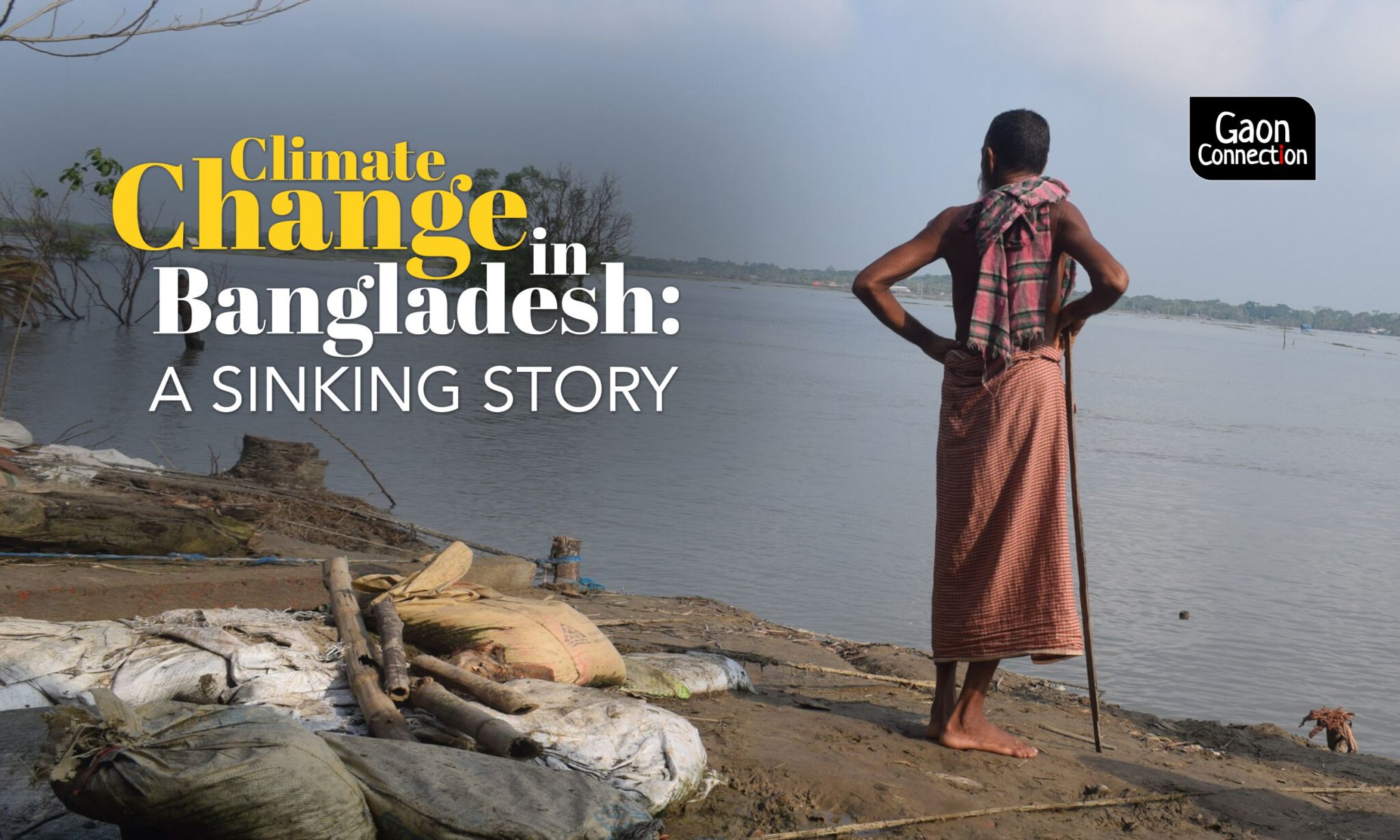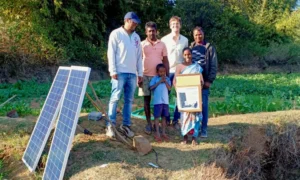Satkhira, Bangladesh
Six people live in a room 12 feet long and 10 feet wide — this is the house of 55-year-old Farooq Hossain Sardar. It is located in Ramnagar mahalla of Naihati union in Rupsha upazila, about 210 kilometres (km) from national capital Dhaka. After everyone winds down for the day, there is no place for Sardar to sleep. For two months, he’s been sleeping on the porch of the mosque near his house.
This is a far cry from his life in his ancestral village of Chakla in Asashuni upazila of Satkhira district on the west coast of Bangladesh, 106 km away from his former home. Frequent natural disasters linked to global warming and climate change have brought Sardar here.
“I was making a living raising crops and doing shrimp farming. But I had to leave my home after Cyclone Amphan hit us last May. Now, I drive a van in the suburbs of Khulna, about 220 km from Dhaka. I have suffered losses in every disaster since the cyclone of 1988 [more than six thousand people died],” Sardar told Gaon Connection.
Chakla, which is adjacent to the Kopotaksha river, is on the verge of disappearing. Elderly residents of the village told Gaon Connection that the string of disasters — the 1988 cyclone, Cyclone Sidr in 2008, Aila in 2009, Fani and Bulbul in 2019 and, finally Amphan — has crippled the lives of its residents. Many families have moved out, and will possibly never return.
There is growing scientific evidence that as oceans heat up due to global warming, the intensity of tropical cyclones increases.
Environmental refugees
It’s been more than nine months now that the Cyclone Amphan hit Bangladesh. But, Pratapnagar union of Asashuni upazila is still under water. Most people living in this union have been forced to change professions. Many have migrated to the city in search of work. Families that seemed poised to beat poverty and climb up the social ladder have found themselves thrown back where they began from.
Sixty-year-old Abdus Sobahan Gazi has seen it all. He used to live in a house built on the ground. After moving houses nine times, he now lives in a hanging house in Kalabagi Bazar. Following Cyclone Aila in 2009, Sutarkhali and Kamarkhola Unions of Dakop upazila suffered heavy damage; Sutarkhali was underwater for five long years. Kalabagi was once surrounded by greenery; it is a barren village now.
Also Read: The ‘hanging village’ of Bangladesh: A glaring reminder of climate change refugees
Morzina Begum, 45, of Kalabagi village, said she had to change her place of residence six times due to floods. “I have lost about twenty five lakh takas in all this shifting,” she said. Since Cyclone Aila in 2009, her family has been living on the roadside.
“We are living like hippopotamus now,” Kulsum Begum, a resident of Fakirkona in Kalabagi village in Khulna district, remarked wryly. Her house floats in the water during the monsoon, and then partly sinks. She has raised the height to survive the water, but it is not very helpful.
Something similar can be witnessed in Gabura Union of Shyamnagar upazila of Satkhira district and Uttar Bedkashi and South Bedkashi Unions of Koyra upazila of Khulna district.
“The hungry river is coming towards us. Our houses are sinking. Where there were roads and houses a year ago, water stands many feet deep. We used to go to the town by road. Now, we take a boat. A new island has been created here after Cyclone Amphan hit,” Akbar Hossain Moral, 65, a resident of Fakirkona, told Gaon Connection.
Also Read: From birth to death: Bangladesh’s landless Manta community survives on boats
Moral has lived in Fakirkona all his life, farmed there and lived off the Sundarbans till Cyclone Aila struck in 2009. Life as he knew it has changed. The local residents used to travel by road to Naliyan Bazar. Now, they have to cross a river. Fakirkona is an island of sorts.
Numerous hanging houses can be seen outside the new embankment in the far south of Sutarkhali union of Dakop upazila. Local residents have built houses at a height to survive the tidal waters. At high tide, the houses seem to be floating in the water. Once farmers, people have now turned to fishing, working in the Sundarbans or migrating to cities.
Hassan Mehdi, chief executive officer of the Coastal Livelihoods and Environment Action Network, a not-for-profit research organisation, said “huge areas are being damaged due to embankment breaks. The village of Jaliakhali in Dakop upazila has gone after Cyclone Aila. As a result of increased erosion, a small part of Kalabagi is on the verge of disappearing. This place will disappear if another big cyclone hits”.
The disasters have taken a toll on livelihoods too. Rafiqul Islam Khokon, executive director of Rupantar, a non-for-profit in Khulna, said land salinity has increased, and so people have been forced to move from raising paddy to fishing to crab farming now. “The coastal region was once called the food store. Rice from this region used to be sent all over our country. Now, we receive rice from the north,” he rued.
Climate change induced debt trap
What follows a natural disaster is a vicious cycle, said Solaiman Sheikh, 65, of Kalabagi village in Dakop upazila. “There is monetary loss. We need more money to overcome that loss. There is no employment available locally. We could have managed by catching shrimp from the river, but that is now banned. So, we migrate,” he told Gaon Connection.
But, even there, they don’t make enough money. “We are caught in a whirlpool,” he added.
Frequent natural disasters result in a terrible debt trap. “More than two hundred families have migrated from Kalabagi village after Aila. Those who could not go have stayed back. All the families in the union received twenty thousand taka from the government as assistance, but what about rehabilitation?” Montaz Uddin Sana, a member of Sutarkhali Union Council, asked Gaon Connection.
“The cost of living is rising. The disasters have exacerbated the river erosion and food crisis in the area,” Sana added.
Mehdi of Coastal Livelihoods and Environment Action Network said that due to the rise in sea level, plants are unable to regenerate due to excess salinity, and Sundari trees, a dominant mangrove species, have become smaller. “Due to the environmental crisis, people in Dakop, Koyra, Shyamnagar and Asashuni areas, who depend on natural resources, do not have professional security,” he added.
All this migration takes a toll on cities too.
Khokon of Rupantar said that despite the lack of industry in Khulna, Barisal and Jessore areas, the population is growing. “This is because of migration from the coastal lowlands. At least two hundred thousand people are moving to the cities every year. They are not able to keep changing their professions,” he added.
Every time they try to start a new life with help from the government and not-for-profit organisations, another disaster strikes and they are back where they began.
Gouranga Nandi, a senior journalist working in the field of environment in southwestern Bangladesh, said infrastructure intervention needed to be done keeping the region in mind. “They can do embankment and river sediment management. Work can be done to eliminate waterlogging. Time is of essence. We cannot delay projects. Arrangements have to be made for displaced people, and long-term food supply or security measures have to be taken,” he told Gaon Connection.
Also Read: Uprooted by Cyclone Amphan, thousands of families in west coast of Bangladesh still displaced
This story was produced with the support of Internews’ Earth Journalism Network.



















